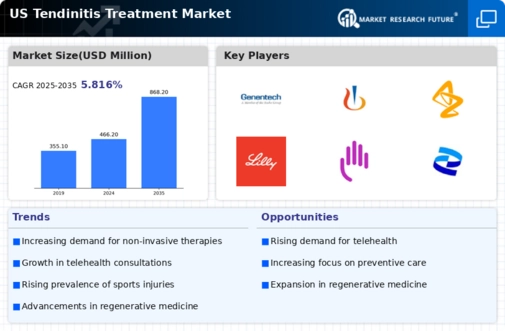The US Tendinitis Treatment Market is a dynamic and competitive landscape characterized by a range of established pharmaceutical and biotechnology companies striving to innovate and provide effective treatment solutions. Tendinitis, a common condition affecting athletes and individuals who engage in repetitive motions, requires targeted therapies that address inflammation and pain. The market comprises a variety of treatment modalities, including anti-inflammatory drugs, corticosteroids, physical therapy, and emerging biological therapies. As the healthcare sector evolves, competition intensifies among leading players, prompting ongoing research and development efforts to enhance therapeutic outcomes while meeting patient needs.
With an increasing focus on personalized medicine and advancements in biologics, the competitive landscape continues to shift, necessitating a keen understanding of market trends and competitor strategies.
Merck & Co has carved a significant presence in the US Tendinitis Treatment Market, leveraging its robust portfolio of anti-inflammatory and therapeutic medications that cater to patients suffering from this condition. The company’s strengths lie in its well-established research and development capabilities, which allow for the timely introduction of innovative products. Merck & Co has invested heavily in clinical studies and collaborations aimed at enhancing patient outcomes, thus solidifying its position as a trusted name in tendinitis treatment.
With a strong brand reputation and a diverse product lineup, including both prescription medications and over-the-counter solutions, Merck & Co effectively addresses the various needs of patients and healthcare providers within this niche market.
Genentech, on the other hand, focuses on innovative biologic therapies that address various inflammatory conditions, including tendinitis, within the US market. The company is recognized for its commitment to research and development, leading to the creation of groundbreaking products that help manage tendinitis-related pain and inflammation. Genentech's investment in advanced therapies positions it favorably in the competitive landscape, allowing it to respond swiftly to market needs and emerging treatment modalities. The company's presence is further enhanced by strategic mergers and acquisitions that have bolstered its capabilities in delivering targeted therapies.
With a focus on patient-centric approaches, Genentech is dedicated to providing comprehensive care solutions that resonate with healthcare providers and enhance the quality of life for individuals suffering from tendinitis in the United States.





















